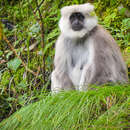en
names in breadcrumbs


The Tarai gray langur (Semnopithecus hector) is an Old World monkey, and was formerly considered a subspecies of the northern plains gray langur. The species is listed as near threatened, as there are probably not many more than 10,000 mature individuals, and it is experiencing a continuing decline.[2]
The Tarai gray langur is native to northern India, Bhutan, and Nepal, and inhabits the Himalayan foothills from Rajaji National Park to southwestern Bhutan. It also lives in the moist deciduous forest of the Siwalik Hills to oak forest ranging from altitudes of 150 to 1,600 m (490 to 5,250 ft).[2]
The Tarai gray langur is arboreal, mainly terrestrial, diurnal, folivorous, and lives in multi-male multi-female groups.[3] Groups have been observed feeding in orchards and crop fields outside of Rajaji National Park.[2]
The Tarai gray langur (Semnopithecus hector) is an Old World monkey, and was formerly considered a subspecies of the northern plains gray langur. The species is listed as near threatened, as there are probably not many more than 10,000 mature individuals, and it is experiencing a continuing decline.